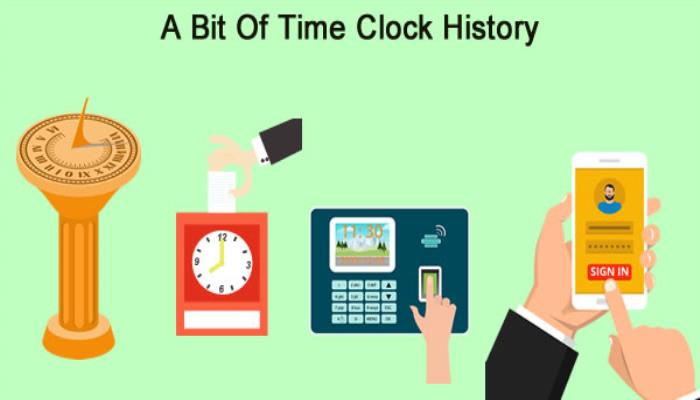The Evolution of Time Tracking: From Punch Cards to Clock In Clock Out Apps

Time tracking has evolved like a butterfly emerging from its cocoon, from the humble punch cards to the sophisticated clock in clock out apps of today. You’ve witnessed this transition, perhaps even experienced it firsthand.
Remember those days when you had to insert a card into a bulky machine to mark your attendance? Then came the era of computer-based systems, eliminating the need for physical cards. Now, you can just tap on a mobile app and voila, your entry and exit times are logged, thanks to your clock in clock out app.
Isn’t it fascinating how technology has streamlined this mundane yet crucial part of our work lives? But how did we get here? Let’s take a step back to explore this transformative journey, and perhaps, glimpse into what the future holds.
Key Takeaways
- Time tracking technology has evolved over time, starting with sundials and mechanical clocks, then progressing to punch card systems and electronic time clocks.
- Computer-based time tracking systems and mobile apps have revolutionized the way employees’ hours and productivity are monitored.
- The benefits of time tracking technology include improved compliance with labor laws, increased accountability and transparency, boosted morale and productivity, cost-efficiency, and accurate payroll.
- The future of time tracking technology will involve more sophisticated and intuitive systems, the integration of AI assistants for personalized tracking, and the potential use of immersive technologies like VR and AR.
The Dawn of Time Tracking
Kicking off the timeline of time tracking, you might be surprised to know it started as early as the ancient civilizations. They didn’t have high-tech gadgets or software, but they did have a keen understanding of the sun’s movements. This awareness led to the creation of sundials, the first primitive form of time tracking.
You’ve got to appreciate the ingenuity of our ancestors, right? They saw a problem, didn’t have a ready solution, and decided to create one. You can imagine how vital this invention was. Days became more structured, tasks got done more efficiently, and humans began to understand time in a more systematic way.
Fast forward to the Middle Ages. We see the invention of mechanical clocks. Now, time tracking wasn’t just a luxury for sunny days. It became a staple in daily life, regardless of the weather.
Understanding Punch Card Systems
As we journey further into the history of time tracking, let’s explore the revolutionary punch card systems that made a significant impact. Also known as time cards, these were physical cards where workers would punch in and out to record their working hours. This system, introduced during the industrial revolution, revolutionized how businesses tracked employee time and attendance.
Now, you might wonder, how did these punch card systems work? Well, it’s quite simple:
- Employees were each given a unique card.
- At the start and end of their shift, they’d insert their card into a punch clock.
- The clock would then stamp the time and date onto the card.
This method not only kept a precise record of worker’s hours but also held them accountable for their punctuality. Despite its simplicity, this system had its drawbacks. For instance, cards could be lost, damaged, or even ‘buddy punched’ by colleagues. Also, manual calculation of hours was time-consuming and prone to human error.
Yet, punch cards were an essential stepping stone in the evolution of time tracking, paving the way for today’s sophisticated clock in, clock out apps.
The Shift to Mechanical Time Clocks
Now let’s dive into the era when businesses began shifting towards the use of mechanical time clocks, a significant step forward in the evolution of time tracking. As you can imagine, this change had a profound impact on the way companies managed their employees’ time. No longer did you have to worry about deciphering handwritten timesheets or dealing with the inaccuracies of punch cards.
Instead, these mechanical marvels provided a more accurate and reliable method of tracking time. You’d simply clock in when you started work and clock out when you finished. The device would then accurately record the time you spent on the job.
But it wasn’t just about accuracy. These mechanical time clocks also streamlined payroll processing. They eliminated the need for manual calculations, thereby reducing the likelihood of errors while saving precious time. The shift to mechanical time clocks marked a major milestone in the evolution of time tracking. It paved the way for even more advanced timekeeping solutions, which we’ll explore in the next section.
The Advent of Electronic Time Clocks
While mechanical time clocks revolutionized time tracking, it didn’t stop there; with technological advancements, came the era of electronic time clocks. It was in the late 20th century when electronic clocks started making rounds in workplaces. These clocks, unlike their predecessors, utilized digital technology and offered more advanced features.
- Improved Accuracy: Electronic time clocks eliminated the possibility of errors associated with manual logging. Precision became the new norm.
- Efficiency and Automation: With electronic time clocks, you no longer had to calculate hours worked manually. The software did it all, saving you time and effort.
- Employee Accountability: These clocks introduced features like unique PINs or biometric identification, making it almost impossible for employees to ‘buddy punch’, ensuring honesty in the workplace.
Sure, it took a while for businesses to fully adapt to this change, but the benefits were undeniable. Not only did they make time tracking an effortless task, but they also paved the way for even more sophisticated time tracking solutions. As a result, electronic time clocks became a pivotal milestone in the evolution of time tracking. Their introduction marked the end of an era and the beginning of a new one, driven by digital technology.
Birth of Computer-Based Time Tracking
In the dawn of the 21st century, you’d witness the transformative shift from electronic to computer-based time tracking, a leap that would forever change the landscape of workforce management. Software replaced old punch clocks and paper timesheets. Computers, with their superior processing power and storage capabilities, offered a more efficient, accurate, and streamlined approach to time tracking.
You’d see software programs that could track not only when employees clocked in and out but also breaks, time off, and overtime. These systems could also be integrated with payroll software, making the process of paying employees more straightforward and less prone to errors. You’d see how the digitization of time tracking eliminated the need for tedious manual record-keeping and data entry.
As a manager, you’d appreciate the convenience and accuracy that computer-based systems offered. You’d have access to real-time data, which allowed for better decision-making and resource planning. On the flip side, as an employee, you’d enjoy the transparency and fairness that these systems brought to the workplace.
It’s clear, the birth of computer-based time tracking marked a significant turning point in the evolution of time tracking.
Time Tracking Software: A Game Changer
Building on the transformative impact of computer-based systems, the advent of time tracking software further revolutionized the way businesses manage their workforce. This game-changing technology brought about a new dawn, making it easier for you to monitor employee hours, manage work schedules, and improve productivity.
Here are three ways time tracking software can be a game changer for your business:
- Enhanced Productivity: It’s not just about clocking in and out. You can track how time is spent, identify inefficiencies, and improve productivity. It’s about making every second count.
- Improved Accountability: With clear records, there’s no room for disputes over hours worked. This boosts trust and accountability within your teams.
- Better Decision Making: You’ve got data at your fingertips. This helps you make informed decisions, manage workload efficiently, and plan for the future effectively.
Rise of Mobile Time Tracking Apps
As the digital age continues to evolve, mobile time tracking apps are emerging as a powerful tool for businesses, enabling you to manage your workforce on the go. They’re revolutionizing the way you track your employees’ hours, tasks, and productivity.
Gone are the days when you’d rely on traditional methods like punch cards. Now, you’ve got the power to monitor time and attendance right at your fingertips. It’s become as easy as tapping a button on your phone or tablet. You can see who’s working, who’s not, and who’s clocked in or out. You’re able to check real-time data and get instant reports.
These apps aren’t just convenient—they’re also cost-effective. You’re saving on resources that would’ve been used for manual tracking and data entry. Plus, they’re accurate, minimizing the risk of errors that can lead to payroll discrepancies.
Mobile time tracking apps are here to stay. They’re evolving with technology and adapting to your ever-changing business needs. So, embrace this innovation. It’s time you harness the power of mobile time tracking apps and take your business to new heights.
Clock In Clock Out Apps: The Present
Today’s business world has embraced the simplicity and efficiency of clock in clock out apps, offering an instant snapshot of employee productivity. You no longer need to manually record hours or rely on memory. These apps allow you to precisely track your employees’ work hours, breaks, overtime, and leave time, ensuring accurate payroll and efficient workforce management.
The value of these apps goes beyond just time tracking. Here are three additional benefits:
- Improved Compliance: These apps help ensure labor law compliance by accurately recording work hours and breaks, reducing the risk of lawsuits and penalties.
- Increased Accountability: By tracking when employees clock in and out, you’re promoting accountability and transparency in your workplace. This can boost morale and productivity.
- Cost-Efficiency: Automated time tracking reduces administrative work and errors in payroll, saving your business time and money.
Future Trends in Time Tracking Technology
Looking ahead, you’ll find that the future of time tracking technology is poised to become even more sophisticated and intuitive. You’ll witness the emergence of smart time trackers, capable of managing and analyzing tasks in real-time. These technologies will be designed to learn from your work habits, making them more efficient and personalized.
Imagine a world where time tracking is seamlessly integrated with artificial intelligence. You’ll have AI assistants that not only track your work hours but also help you manage your time more efficiently. They’ll predict your workload, suggest breaks when you’re overworked, and even guide you through your day.
Real-time analytics will also play a pivotal role. You’ll get immediate insights into your productivity patterns, enabling you to make swift decisions to improve your work habits.
There’s also the potential for immersive technologies like VR and AR to revolutionize time tracking. You could be navigating your tasks in a virtual workspace, making time management more interactive and engaging.
Conclusion
So, there you have it. From humble punch cards to savvy clock in clock out apps, time tracking’s evolution has been remarkable.
It’s not just about timekeeping anymore, it’s about efficiency, productivity, and data accuracy.
With future trends pointing towards AI and biometric advancements, it’s clear we’re just getting started.
Embrace the change, because time tracking, as we know it, is set to get even smarter.
